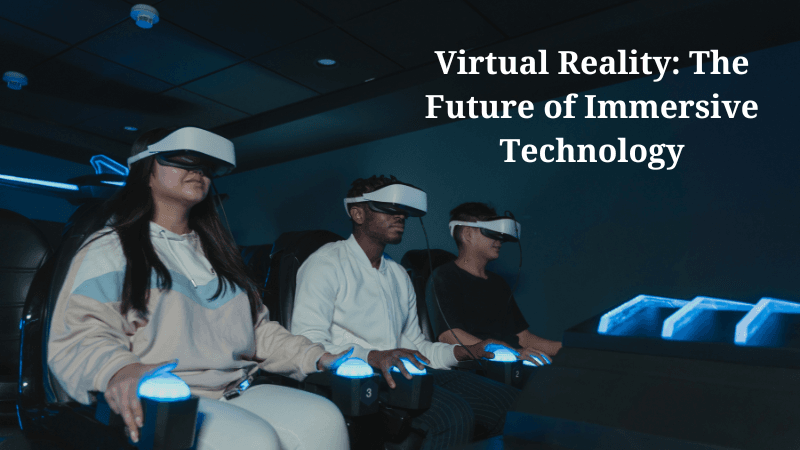Virtual Reality (VR) is more than just a sci-fi dream; it’s a game-changing technology. VR is transforming industries, entertainment, and how we connect with one another. From gaming and training to healthcare and social interactions, VR is changing how we engage with digital content. This article explores the history, principles, applications, benefits, and future of VR, providing a clear view of this exciting technology.

What is Virtual Reality?
Virtual Reality (VR) is an immersive tech that creates a simulated environment. It lets users interact with a 3D, computer-generated world. Unlike regular screens, VR puts users inside the experience with headsets, motion tracking, and controllers. The aim is to make the digital world feel real, using advanced graphics, sensory feedback, and artificial intelligence. VR’s potential goes beyond entertainment; it has applications in education, healthcare, and business.
The History of Virtual Reality
VR might seem modern, but its roots go back decades. The idea began in the 1960s with the “Sensorama,” an early immersive machine that simulated environments using visuals and sounds. In the 1980s, NASA and tech pioneers used VR for simulations and training. The 1990s brought consumer VR, but the tech wasn’t ready. Now, thanks to powerful computing and high-resolution displays, VR is finally becoming mainstream.
How Virtual Reality Works
VR combines several technologies to create an immersive experience. A VR headset displays stereoscopic images with a wide field of view. Sensors track head and hand movements, turning real-world actions into the digital space. Controllers let users interact with objects, while haptic feedback simulates touch. Advanced systems also include eye tracking, motion capture, and spatial audio for added realism.
Types of Virtual Reality
Different types of VR experiences exist depending on immersion levels:
- Non-Immersive VR – Basic 3D simulations on a monitor, like video games.
- Semi-Immersive VR – Partial immersion using large screens or projectors for simulations.
- Fully Immersive VR – The highest immersion level with headsets and motion tracking.
- Augmented Reality (AR) and Mixed Reality (MR) – AR adds digital elements to the real world, while MR blends virtual and physical interactions.
Applications of Virtual Reality
1. Gaming and Entertainment
VR gaming offers unmatched immersion, letting players step into digital worlds. Platforms like Oculus, PlayStation VR, and HTC Vive change how games are played. Beyond gaming, VR is reshaping cinema, live events, and virtual tourism with interactive storytelling.
2. Education and Training
VR is a powerful educational tool, making complex subjects easier to grasp. Virtual classrooms and historical reconstructions enhance learning. Professional training in fields like medicine and aviation uses VR to provide safe, hands-on experiences.
3. Healthcare and Therapy
In healthcare, VR aids pain management, mental health therapy, and surgical training. It helps patients face fears through exposure therapy. VR also supports rehabilitation with interactive exercises for injury recovery.
4. Business and Marketing
Businesses use VR to improve customer experiences and product demos. Real estate firms offer virtual property tours, allowing buyers to explore homes remotely. VR tools also enhance remote meetings and training.
5. Engineering and Design
Architects and designers use VR to visualize projects before construction. Virtual prototypes let them test product designs, saving time and costs. Car makers and industrial designers use VR to improve safety and functionality.
6. Military and Defense
The military uses VR for combat training and mission simulations. Soldiers train in realistic environments, enhancing decision-making skills. VR flight simulators let pilots practice various scenarios safely.
The Benefits of Virtual Reality
VR provides several advantages across industries:
- Better Learning & Training: Offers hands-on experience without real-world risks.
- Higher Engagement: Immersive settings boost participation.
- Cost Savings: Cuts expenses in training and design.
- Remote Access: Enables global collaboration without travel.
- Improved Mental Health Care: Supports therapy and rehabilitation.
- Transformed Entertainment: Changes gaming and storytelling.
Challenges and Limitations of Virtual Reality
VR has its challenges:
- High Costs: Quality VR systems need expensive hardware.
- Motion Sickness: Some users may feel dizzy or nauseous.
- Limited Content: Quality VR content is still developing.
- Technical Needs: Requires powerful computing for smooth performance.
- Social Isolation: Long VR use might cut real-world interactions.
- Privacy Concerns: Data collection raises ethical questions.
FAQ Section
VR creates a complete digital world. AR adds digital elements to the real world. MR blends digital and physical spaces for interactive experiences.
Top VR headsets include the Oculus Quest 2, HTC Vive Pro, PlayStation VR, and Valve Index. They offer different immersion levels and price points.
Yes, VR helps with exposure therapy, stress relief, and PTSD treatment by allowing patients to face fears in a safe space.
High-end VR systems can be costly, but budget-friendly options like standalone headsets are making the technology more accessible.
Industries such as gaming, education, healthcare, real estate, military, and design benefit greatly from VR’s immersive features.
The Future of Virtual Reality
The future of VR looks bright, with AI, 5G, and haptic tech enhancing realism. Wireless headsets and cloud-based platforms will make VR experiences more accessible. The metaverse will integrate VR into social interactions, workspaces, and commerce. As hardware costs decrease and content expands, VR will play a big role in daily life, transforming education, healthcare, and business.